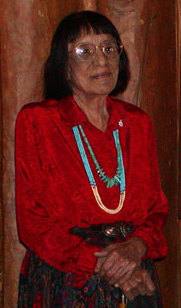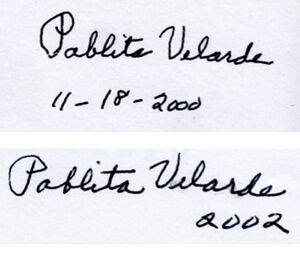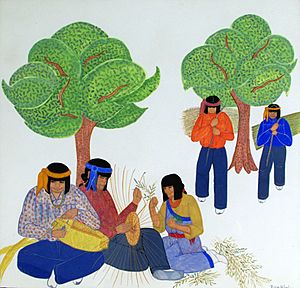Pablita Velarde facts for kids
Quick facts for kids
Pablita Velarde
|
|
|---|---|
 |
|
| Born |
Tse Tsan
September 19, 1918 |
| Died | January 12, 2006 (aged 87) |
| Nationality | American (Santa Clara Pueblo) |
| Education | Dorothy Dunn, Santa Fe Studio Art School |
| Known for | American Indian painting, Pueblo art |
| Spouse(s) | Herbert Hardin |
| Children | 3 |
| Awards | Palmes Académiques |
Pablita Velarde (born September 19, 1918 – died January 12, 2006) was an amazing American Pueblo artist and painter. Her birth name was Tse Tsan, which means "Golden Dawn" in the Tewa language. She is famous for her unique paintings that show the traditional life and culture of the Pueblo people.
Contents
Early Life and Learning to Paint
Pablita Velarde was born on September 19, 1918, in Santa Clara Pueblo, New Mexico, near Española, New Mexico. When she was about five years old, her mother passed away. Pablita and two of her sisters then went to St Catherine's Indian School in Santa Fe.
At age fourteen, Pablita got into the Santa Fe Studio School at the Santa Fe Indian School. She was one of the first girls to study art there. Her teacher was Dorothy Dunn, and Pablita became very good at a style called "flatstyle" painting. This style used flat colors and clear outlines.
Pablita worried that old Native American ways of life were changing too fast. She called her paintings "memory paintings" because they helped keep the old traditions alive. While at school, she also became friends with another artist, Tonita Peña, who inspired her work.
Pablita's Art and Style
At first, Pablita Velarde only used watercolors for her paintings. But later, she learned how to make her own paints from natural pigments. This process was similar to an old painting method called fresco secco.
She would find minerals and rocks, then grind them into a powder using a metate and mano (special grinding stones). From this powder, she made her own "earth paints." These paints gave her artwork a special look.
In 1939, Pablita got a special job from the National Park Service. This was part of a program called the Works Progress Administration (WPA). She was asked to paint scenes of traditional Pueblo life for visitors at the Bandelier National Monument.
After this project, Pablita became one of the most successful Native American painters of her time. She had art shows all over the United States, including in New Mexico, Florida, and California. The WPA also paid for her to paint large murals.
In 1960, Pablita wrote a book called "Old Father the Story Teller." It shared six traditional Tewa tribal stories.
In an interview in 1979, Pablita said that painting was not usually seen as a job for women back then. She explained, "A woman was supposed to be just a woman, like a housewife and a mother and chief cook. Those were things I wasn't interested in." This shows how determined she was to follow her passion for art.
You can see Pablita Velarde's artwork in many places. Some of her paintings are in museums like the Bandelier National Monument museum, the Museum of Indian Arts and Culture, and the Smithsonian National Museum of Natural History.
In 2012, Pablita's granddaughter, Margarete Bagshaw, opened the Pablita Velarde Museum of Indian Women in Santa Fe. This museum honored Pablita's amazing work and other female Native American artists. Sadly, the museum closed in 2015 after Margarete passed away.
Family Life
In 1942, Pablita Velarde married Herbert Hardin. They had three children and lived in the Sandia Mountains near Albuquerque, New Mexico. Pablita's daughter, Helen Hardin, and her granddaughter, Margarete Bagshaw, also became famous artists. This shows how artistic talent ran in their family!
Awards and Special Recognitions
Pablita Velarde received many awards for her incredible art:
- In 1953, she was the first woman to win the Grand Purchase Award at the Philbrook Museum of Art’s Annual Exhibition of Contemporary Indian Painting.
- In 1954, the French government gave Pablita and eleven other Native American artists a special award called the Palmes Académiques. This was the first time a foreign country honored Native American artists for their art. Other artists who received this award included Harrison Begay, Allan Houser, and Marie Martinez.
- In 1977, she received the New Mexico Governor's Award.
- In 1988, she was named a Santa Fe Living Treasure.
- In 1990, she received a Lifetime Achievement Award from the National Women's Caucus for Art.
See also



